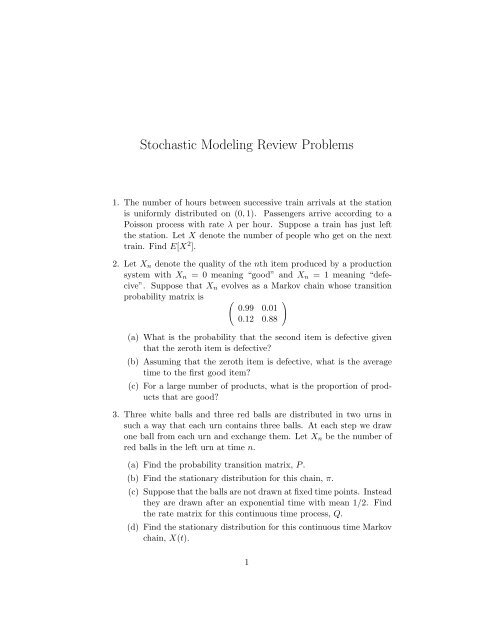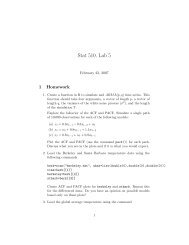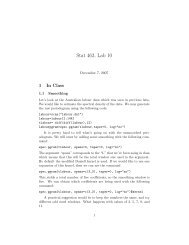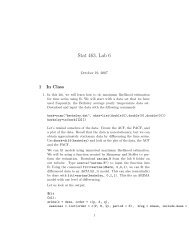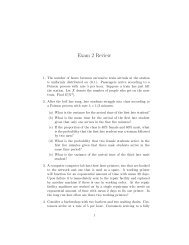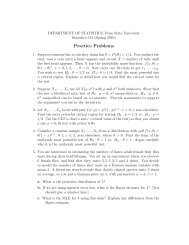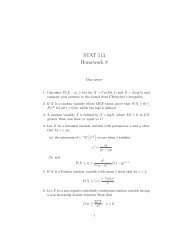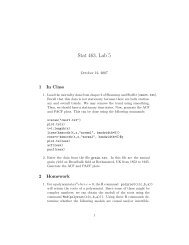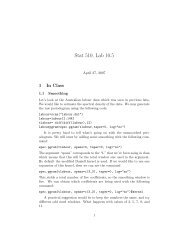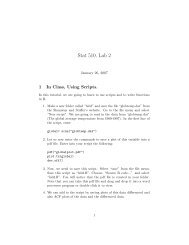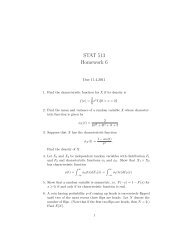Stochastic Modeling Review Problems - John Fricks
Stochastic Modeling Review Problems - John Fricks
Stochastic Modeling Review Problems - John Fricks
Create successful ePaper yourself
Turn your PDF publications into a flip-book with our unique Google optimized e-Paper software.
<strong>Stochastic</strong> <strong>Modeling</strong> <strong>Review</strong> <strong>Problems</strong><br />
1. The number of hours between successive train arrivals at the station<br />
is uniformly distributed on (0, 1). Passengers arrive according to a<br />
Poisson process with rate λ per hour. Suppose a train has just left<br />
the station. Let X denote the number of people who get on the next<br />
train. Find E[X 2 ].<br />
2. Let X n denote the quality of the nth item produced by a production<br />
system with X n = 0 meaning “good” and X n = 1 meaning “defecive”.<br />
Suppose that X n evolves as a Markov chain whose transition<br />
probability matrix is ( )<br />
0.99 0.01<br />
0.12 0.88<br />
(a) What is the probability that the second item is defective given<br />
that the zeroth item is defective?<br />
(b) Assuming that the zeroth item is defective, what is the average<br />
time to the first good item?<br />
(c) For a large number of products, what is the proportion of products<br />
that are good?<br />
3. Three white balls and three red balls are distributed in two urns in<br />
such a way that each urn contains three balls. At each step we draw<br />
one ball from each urn and exchange them. Let X n be the number of<br />
red balls in the left urn at time n.<br />
(a) Find the probability transition matrix, P .<br />
(b) Find the stationary distribution for this chain, π.<br />
(c) Suppose that the balls are not drawn at fixed time points. Instead<br />
they are drawn after an exponential time with mean 1/2. Find<br />
the rate matrix for this continuous time process, Q.<br />
(d) Find the stationary distribution for this continuous time Markov<br />
chain, X(t).<br />
1
4. After the bell has rung, late students straggle into class according to<br />
a Poisson process with rate λ = 1/3 minutes.<br />
(a) What is the variance for the arrival time of the first late student?<br />
(b) What is the mean time for the arrival of the first late student<br />
given that only one arrives in the first five minutes?<br />
(c) If the proportion of the class is 40% female and 60% male, what<br />
is the probability that the first late student was a woman followed<br />
by two men?<br />
(d) What is the probability that two female students arrive in the<br />
first five minutes given that three male students arrive in the<br />
same time period?<br />
(e) What is the variance of the arrival time of the third late male<br />
student?<br />
5. A computer computer lab has three laser printers, two that are hooked<br />
to the network and one that is used as a spare. A working printer<br />
will function for an exponential amount of time with mean 20 days.<br />
Upon failure it is immediately sent to the repair facility and replaced<br />
by another machine if there is one in working order. At the repair<br />
facility machines are worked on by a single repairman who needs an<br />
exponential amount of time with mean 2 days to fix one printer. In<br />
the long run how often are there two working printers?<br />
6. Consider a barbershop with two barbers and two waiting chairs. Customers<br />
arrive at a rate of 5 per hour. Customers arriving to a fully<br />
occupied shop leave without being served. Find the stationary distribution<br />
for the number of customers in the shop, assuming that the<br />
service rate for each barber is 2 customers per hour.<br />
7. Customers arrive at the Shortstop convenience store at a rate of 20<br />
per hour. When two or fewer customers are present in the checkout<br />
line, a single clerk works and the average service time is 3 minutes.<br />
However, when there are three or more customers present, an assistant<br />
comes over to bag up the groceries and reduces the service time to 2<br />
minutes. Assuming the service times are exponentially distributed,<br />
find the stationary distribution.<br />
2


